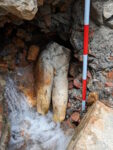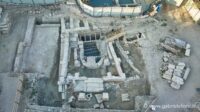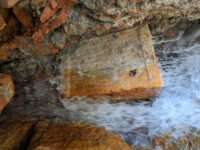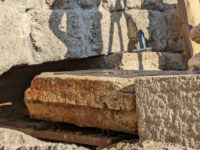 The excavation of the ancient Etruscan and Roman sacred baths at San Casciano dei Bagni in Tuscany has unearthed another extraordinary treasure: a marble statue of Apollo Sauroctonos (Apollo Lizard-killer), depicting a youthful Apollo leaning against a tree about to catch a lizard climbing up the trunk. It’s a Roman copy of a bronze original by the renown Greek sculptor Praxiteles, one of about forty known to exist.
The excavation of the ancient Etruscan and Roman sacred baths at San Casciano dei Bagni in Tuscany has unearthed another extraordinary treasure: a marble statue of Apollo Sauroctonos (Apollo Lizard-killer), depicting a youthful Apollo leaning against a tree about to catch a lizard climbing up the trunk. It’s a Roman copy of a bronze original by the renown Greek sculptor Praxiteles, one of about forty known to exist.
 The statue of Apollo was discovered this summer on the edge of the Great Bath, the hot spring sacred to the Etruscans and Romans. Life-sized at around six feet high, it was broken into sections but the pieces are large and most of them have been recovered so that the statue can be reassembled almost entire.
The statue of Apollo was discovered this summer on the edge of the Great Bath, the hot spring sacred to the Etruscans and Romans. Life-sized at around six feet high, it was broken into sections but the pieces are large and most of them have been recovered so that the statue can be reassembled almost entire.
 Apollo was one of the major deities of the sanctuary. The hot springs and mineral waters were believed to cure illness, and the gods connected to health were worshipped there by people seeking cures. Apollo was the god of healing and diseases, so petitioners left votive offerings — coins, figurines, sculptures of afflicted body parts, effigies of the gods — to petition a cure for what ailed them. The lizard Apollo is hunting in the statue had medical relevance as well. Lizards were key ingredients in medications for diseases of the eye. Bronze votive figurines of lizards have been found in the San Casciano baths, offerings from people with ophthalmic complaints.
Apollo was one of the major deities of the sanctuary. The hot springs and mineral waters were believed to cure illness, and the gods connected to health were worshipped there by people seeking cures. Apollo was the god of healing and diseases, so petitioners left votive offerings — coins, figurines, sculptures of afflicted body parts, effigies of the gods — to petition a cure for what ailed them. The lizard Apollo is hunting in the statue had medical relevance as well. Lizards were key ingredients in medications for diseases of the eye. Bronze votive figurines of lizards have been found in the San Casciano baths, offerings from people with ophthalmic complaints.
 One of the extraordinary group of bronzes discovered in 2022 was a dancing Apollo figure from the oldest basin at the sanctuary. It likely dates to around 100 B.C. Based on its size and style, the marble Apollo Sauroctonos probably dates to the 2nd century A.D. It was broken in the early 5th century A.D., when the Christianization of the territory led to the temples and statuary being toppled into the basins and the sanctuary closed.
One of the extraordinary group of bronzes discovered in 2022 was a dancing Apollo figure from the oldest basin at the sanctuary. It likely dates to around 100 B.C. Based on its size and style, the marble Apollo Sauroctonos probably dates to the 2nd century A.D. It was broken in the early 5th century A.D., when the Christianization of the territory led to the temples and statuary being toppled into the basins and the sanctuary closed.
Another noteworthy discovery made this summer is a travertine votive altar with a bilingual inscription in Latin and Etruscan. It dates to the 1st century A.D. The inscriptions reference the sacred hot springs, a testament to the coexistence of Etruscan and Latin cultures at the sanctuary well into the imperial era.


* This article was originally published here














No comments:
Post a Comment